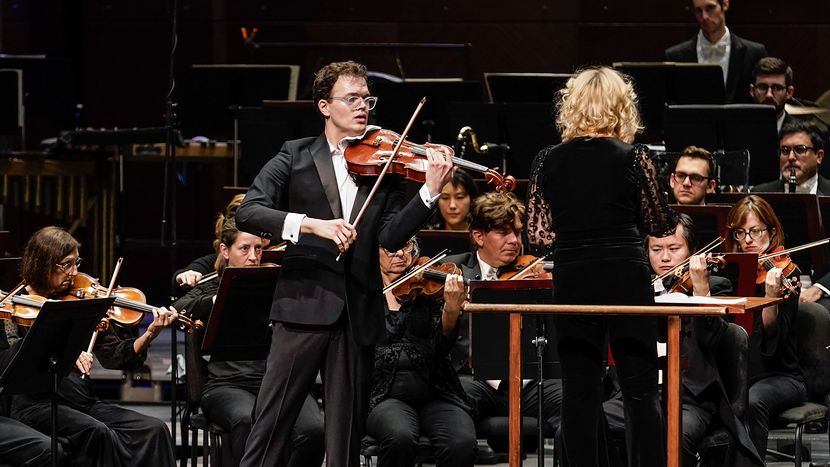
FORT WORTH — We’re blessed with two excellent professional orchestras around here, playing in two very fine halls. After the Dallas Symphony Orchestra’s splendid Saturday night concert at the Meyerson Symphony Center, the Fort Worth Symphony did itself proud Sunday afternoon at Bass Performance Hall.
The FWSO’s guest conductor this time was Russian-born, Berlin-based Anna Skryleva. An alumna of the 2015 Dallas Opera Hart Institute for Women Conductors, she has a significant international career going.
As in a previous Fort Worth gig, in October 2021, she had the orchestra playing brilliantly and elegantly. The program paired final orchestral works by roughly contemporary composers who fled communism and World War II to land, with mixed feelings, in the United States.
Béla Bartók was represented by the Viola Concerto left in sketches at his death in 1945, and by the 1931 Hungarian Sketches he arranged from earlier piano pieces. Soloist in the concerto was the FWSO’s principal violist, DJ Cheek. The concert’s second half was devoted to Rachmaninoff’s Symphonic Dances, composed three years before his death in 1943.
The Hungarian Sketches suggest contrasting songs and dances from Hungarian folk music, tarted up with mischievous dissonance here and there. (Only the last, “Swineherd’s Dance,” quotes an actual folk tune.) Skryleva had the orchestra on high alert, dispatching rhythms with precision, displaying wide ranges of dynamics and colors.
The mellow-voiced viola doesn’t get a lot of concerto exposure, so presumably violists are grateful for Bartók’s contribution. But, given the sketchy manuscripts the dying composer left, the usual performing edition — used here — is at least half the work of Bartók’s friend and fellow émigré, Tibor Serly.
In the company of two masterpieces from the end of Bartók’s life, the Concerto for Orchestra and Third Piano Concerto (the latter requiring a relatively slight completion), the Viola Concerto seems something of a grab bag.
It has its admirers, but I’m not among them. Surely it would have been far greater had Bartók lived to finish it.
Cheek dispatched its challenges with impressive aplomb, intonation slipping briefly in just a couple of busy spots. Skryleva and the orchestra didn’t make a silk purse of the piece, but they gave an alert, caring performance. Next time, though, how about the William Walton Viola Concerto?
The masterpiece status of Rachmaninoff’s Second Symphony and Second and Third piano concertos surely needs no defense. I’ve never been entirely convinced by the Third Symphony and Fourth Piano Concerto, but the Symphonic Dances evince a fresh new voice.
Bright colors and rhythmic intensities of the New World mingle with reminiscences, variously warm hearted and sad, of an imperial Russia gone forever. There’s also, of course, the “Dies irae,” the Requiem hymn about death and Last Judgement.
Slow starts to the second movement waltzes were perhaps overdone, but otherwise Skryleva produced a gripping performance. From the stamping rhythms at the start to soaring melodies that ensued, the orchestra played gloriously, with particularly eloquent wind solos.
I do wish the FWSO would retract those sound-dulling curtains from side walls. They’re meant for amplified sound, not orchestral music. And how about programs in print that doesn’t require a magnifying glass?
